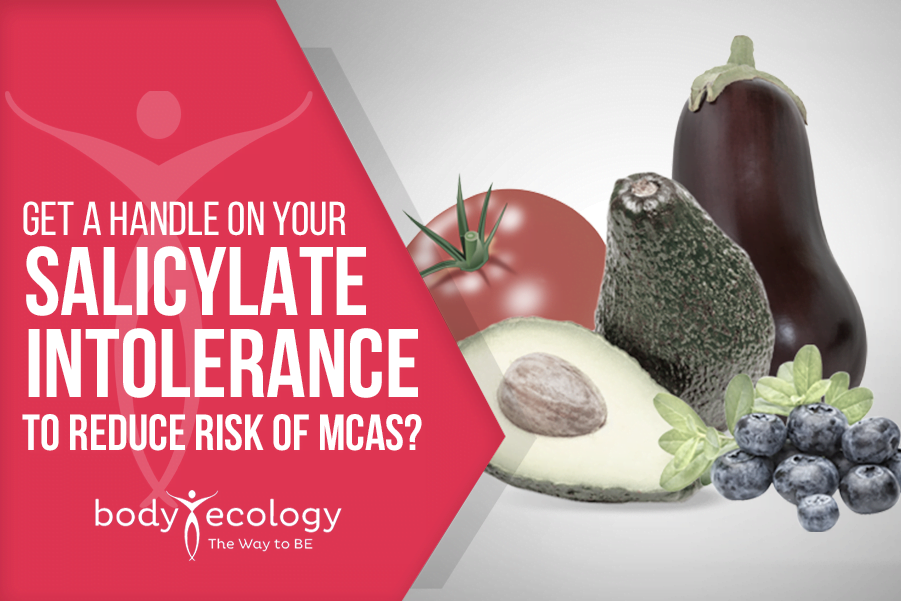
3 ways to curb salicylate sensitivity (and MCAS risk)
 Symptoms commonly associated with salicylate sensitivity include rhinitis (runny nose), asthma, and nasal polyps.
Symptoms commonly associated with salicylate sensitivity include rhinitis (runny nose), asthma, and nasal polyps.
But hives, rashes, swelling, sore eyes, diarrhea, nausea, poor memory and concentration, headaches, bedwetting, coughs, fatigue, tinnitus, depression, and gut inflammation are also reported.
Salicylate sensitivity is something that typically develops over time, with the severity of sensitivity varying from person to person. For those who are intolerant to salicylates, this dysfunction can trigger a cascade of uncomfortable and sometimes serious symptoms like those mentioned above.
The unexpected reason leaky gut may be behind your MCAS
In general, people with gut issues, such as yeast, bacterial overgrowth, or digestive diseases like Crohn’s and IBS, can develop salicylate intolerance as a result of leaky gut syndrome.
With a leaky gut, the lining of the intestines becomes permeable. The tight junctions found in a healthy gut wall open up, allowing material from the intestines to enter into the bloodstream — including undigested food particles and brain-damaging toxins like ammonia.
Leaky gut may actually create salicylate intolerance, which, in turn, may activate one of the more difficult immune disorders — Mast Cell Activation Syndrome, or MCAS.1,2
Mast cells are important immune system cells that can be found in your body’s connective tissue. Mast cells secrete histamine, and contrary to what you may think about histamine, it’s not bad.
In fact:
- The release of histamine is part of a normal immune response.
- When there’s an injury or infection in your body, histamine sends signals to the area of injury to help your body heal.
- If your immune system encounters a foreign invader, like pollen or mold, histamine is secreted from the mast cells in an effort to protect you.
- Mast Cell Activation Syndrome occurs when too much histamine is released or released at the wrong time as a result of stress or other threats.3

Symptoms of MCAS are similar to salicylate sensitivity and may include cramping, diarrhea, nausea, abdominal pain, and gut inflammation. Other commonly affected areas may involve the skin, nervous system, and the heart — typically in the form of low blood pressure and/or rapid heartbeat.4 Symptoms may be mild, severe, or anything in between.
Gut issues, such as yeast overgrowth (candida) and mold infection, need to be addressed. Both infections may contribute to a leaky gut. With candida and/or mold, high oxalates will also be a concern.
We’ve been recommending the addition of fermented vegetables to your diet for over 20 years. Find out why.
Reduce your salicylate sensitivity in 3 simple steps

See the list of foods high in salicylates here. But don’t avoid these foods forever as they supply a variety of nutrients and help build a healthy microbiome.
Second, focus on healing your gut lining:
- Start with a diet free of gluten, dairy, grains, and sugar.
- Plus, you’ll need to remove the source of the inflammation — which can be from yeast, mold, or bacteria.
Third, re-establish a healthy inner ecosystem in your digestive tract with prebiotics, probiotics, and fibers in your diet.
What about fermented foods? Certain fermented foods do wonders for establishing a diverse inner ecosystem. They can even help heal the gut lining and keep the bad guys at bay. But the right fermented foods must be introduced at the right time. In fact, timing is everything.
If your “histamine bucket” is overflowing, then wait a few weeks to add in fermented vegetables and probiotic liquids like CocoBiotic, InnergyBiotic, and BeetBiotic. If you have SIBO (Small Intestinal Bacterial Overgrowth), wait until you have this infection under control before adding bacteria with lactic acid back into your diet.
Lactobacillus plantarum produce lactic acid but also degrade histamine.5
So, these superstar bacteria (present in cultured vegetables, kimchi, and sauerkraut) will ultimately help protect against further relapses of bacterial overgrowth in the intestines and help control histamine levels.
Supporting the gut nutritionally with a proper diet like The Body Ecology food plan is your first step and optimal defense in tackling most of these conditions, including helping to restore the intestinal lining; calm histamine reactions; alleviate food sensitivities; address yeast, fungal, and bacterial infections; and return the gut to a stable environment.
Focusing on your gut health is essential — no matter what condition you have.
As we like to teach at BE, the Universal Principle of Step by Step tells us where to begin our journey of healing (and it is a journey):
1. Increase energy.
2. Correct digestion.
3. Conquer infections.
4. Cleanse out the toxins.
The only true, lasting solution to help increase energy, address multiple infections, cleanse out toxins, and even maintain a balanced weight is to correct and heal your digestive tract — and, of course, establish a healthy microbiome.
REFERENCES:
- 1. Cuomo R, Andreozzi P, Zito FP, Passananti V, De Carlo G, Sarnelli G. Irritable bowel syndrome and food interaction. World J Gastroenterol. 2014;20(27):8837-8845. doi:10.3748/wjg.v20.i27.8837.
- 2. Rechenauer T, Raithel M, Götze T, et al. Idiopathic Mast Cell Activation Syndrome With Associated Salicylate Intolerance. Front Pediatr. 2018;6:73. Published 2018 Mar 27. doi:10.3389/fped.2018.00073.
- 3. Leru PM, Anton VF, Ureche C, Zurac S, Bratu O, Neagoe CD. Mast cell activation syndromes – evaluation of current diagnostic criteria and laboratory tools in clinical practice (Review). Exp Ther Med. 2020;20(3):2348-2351. doi:10.3892/etm.2020.8947.
- 4. Kolck UW, Haenisch B, Molderings GJ. Cardiovascular symptoms in patients with systemic mast cell activation disease. Transl Res. 2016 Aug;174:23-32.e1. doi: 10.1016/j.trsl.2015.12.012. Epub 2015 Dec 28. PMID: 26775802.
- 5. Kung HF, Lee YC, Huang YL, Huang YR, Su YC, Tsai YH. Degradation of Histamine by Lactobacillus plantarum Isolated from Miso Products. J Food Prot. 2017 Oct;80(10):1682-1688. doi: 10.4315/0362-028X.JFP-17-135. PMID: 28885051.








